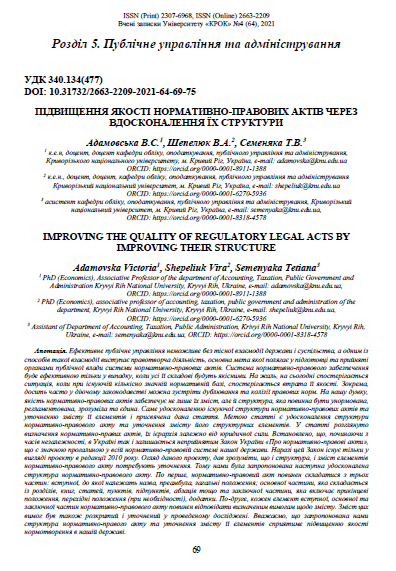IMPROVING THE QUALITY OF REGULATORY LEGAL ACTS BY IMPROVING THEIR STRUCTURE
DOI:
https://doi.org/10.31732/2663-2209-2021-64-69-75Keywords:
normative legal act, rulemaking, structure of a normative legal ACT, Law, Code, bylawsAbstract
Effective public administration is impossible without close interaction between the state and society, and one of the ways of such interaction is law-making activities, the main purpose of which is to prepare and adopt a system of normative legal acts by public authorities. The regulatory support system will be effective only if all its components are of high quality. Unfortunately, today there is a situation where, with the existing quantitatively significant regulatory framework, there is a loss of its quality. In particular, quite often in the current legislation you can find duplication and conflicts of legal norms. In our opinion, the quality of normative legal acts is ensured not only by their content, but also by the structure, which should be normalized, regulated, clear and unified. The purpose of the article is to improve the structure of the legal act and clarify the content of its structural elements. This article is devoted to improving the existing structure of normative legal acts and clarifying the content of its elements. The article considers the definition of normative legal acts, their hierarchy depending on their legal force. It is established that since the time of independence, the law of Ukraine "on normative legal acts" has remained rejected in Ukraine, which is a significant gap in the entire normative legal system of our state. Currently, this law exists only in the form of a draft as amended in 2010. The review of this project made it clear that both the structure and content of the elements of the Regulatory Act need to be clarified. Therefore, we have proposed the following improved structure of the normative legal act. First, a normative legal act should consist of three parts: the introductory part, which includes the title, preamble, general provisions; the main part, which consists of sections, books, articles, paragraphs, sub-paragraphs, paragraphs, etc. and the final part, which includes final provisions, transitional provisions (if necessary), appendices. Secondly, each element of the introductory, main and final parts of a normative legal act must meet certain content requirements. The content of these requirements was also disclosed and clarified in the study. We believe that our proposed structure of the normative legal act and clarification of the content of its elements will contribute to improving the quality of rule-making in our country.
Downloads
References
Про нормативно-правові акти : Проект Закону від 30.11.2010 р. № 1655-VII. URL : http://w1.c1.rada.gov.ua/pls/zweb2/webproc4_2?pf3516=0922&skl=8.
Про затвердження Порядку подання нормативно-правових актів на державну реєстрацію до Міністерства юстиції України та проведення їх державної реєстрації : наказ Міністерства Юстиції України № 34/5 від 12.04.2005 р. URL: http://ddr.minjust.gov.ua/uk/c7ae49431c625008764d1b12dd2fe566.
Словарь русского языка: В 4-х т. РАН, Ин-т лингвистич. исследований; Под ред. А. П. Евгеньевой. 4-е изд., стер. Москва : Рус. яз.; Полиграфресурсы, 1999
Оніщенко Н. М. Проблеми ефективності законодавства та сучасний розвиток. Віче. 2007. № 12. С. 3–6.



